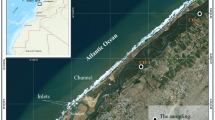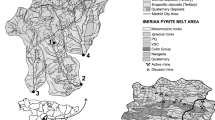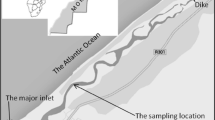Abstract
Vertical distribution of some rare earth elements (REEs) and trace elements through a Jurumirim Reservoir sediment core is presented. REE fractionation using BCR sequential extraction protocol was performed to verify REE mobility in the environment. Three steps (exchangeable, reducible, oxidizable) and residual fractions were studied and REE distribution for each was evaluated by ICP-MS. REEs showed a higher affinity for the reducible phase. Instrumental neutron activation analysis was also applied to sediment samples to determine the total mass fraction for some REE (Ce, Eu, La, Lu, Nd, Sm, Tb, and Yb). The diagrams normalized to chondrite values were used for a REE distribution pattern evaluation.





Similar content being viewed by others
References
Esteves FA (1988) Fundamentos de Limnologia. Interciência/FINEP, Rio de Janeiro
CETESB (2011) Qualidade das Águas Superficiais do Estado De São Paulo 2010. CETESB, São Paulo
Chapman PM, Wang F, Germano JD, Batley G (2002) Pore water testing and analysis: the good, the bad and the ugly. Mar Poll Bull 44:359–366
Cohen AS (2003) Paleolimnology. The history and evolution of lakes systems. Oxford, New York
Audry S, Schaefer J, Blanc G, Jousnneau J-M (2004) Fifty-year sedimentary record of heavy-metal pollution (Cd, Zn, Cu, Pb) in Lot River Reservoirs (France). Environ Pollut 132:413–426
Gomes FC, Godoy JM, Godoy MLDP, Carvalho ZL, Lopes RT, Sanchez-Cabeza JAS, Lacerda LD, Wasserman JL (2009) Metal concentrations, fluxes, inventories and chronologies in sediments from Sepetiba and Ribeira Bays: a comparative study. Mar Poll Bull 59:123–133
Franklin RL, Fávaro DIT, Damatto SR (2016) Trace metal and rare earth elements in a sediment profile from the Rio Grande Reservoir, São Paulo, Brazil: determination of anthropogenic contamination, dating, and sedimentation rates. J Radioannal Nucl Chem 307(1):99–110
Vukovic Z, Vukovic D, Radenkovic M, Stankovic S (2012) A new approach to the analysis of the accumulation and enrichment of heavy metals in the Danube river sediment along the Iron Gate reservoir in Serbia. J Serb Chem Soc 77(3):381–392
Quináglia GA (2012) Caracterização de Níveis basais de concentração de Metais nos sedimentos do sistema estuarino da baixada Santista. Biblioteca24horas, São Paulo
Luiz-Silva W, Machado W, Matos RHR (2008) Multi-elemental contamination and historic record in sediments from the Santos-Cubatão estuarine system. Brazil J Braz Chem Soc 19(8):1490–1500
Sutherland RA (2000) Bed sediment-associated trace metals in an urban stream, Oahu, Hawaii. Environ Geol 39(6):611–627
Donahoe RJ, Liu C (1998) Pore water geochemistry near the sediment-water interface of a zoned, freshwater wetland in the southeastern United States. Environ Geol 33(2/3):143–153
Munk L, Faure G (2004) Effects of pH fluctuations on potentially toxic metals in the water and sediment of the Dillon Reservoir, Summit County. Colorado Appl Geochem 19:1065–1074
Wiechula D, Loska K, Korus I (2005) Lead partitioning in the bottom sediment of Rybnik reservoir (Southern Poland). Water Air Soil Pollut 164:315–327
Pereira JC, Silva AKG, Nalini HA Jr, Silva EP, Lena JC (2007) Distribuição, fracionamento e mobilidade de elementos traço em sedimentos superficiais. Quím Nova 30(5):1249–1255
Bevilacqua JE, Silva IS, Lichtig J, Masini JC (2009) Extração seletiva de metais pesados em sedimentos de fundo do rio Tietê, São Paulo. Quím Nova 32(1):26–33
Korfali SI, Jurdi MS (2011) Speciation of metals in bed sediment and water of Qaraaoun Reservoir, Lebanon. Environ Monit Assess 178:563–579
Gleyzes C, Tellier S, Astruc M (2002) Fractionation studies of trace elements in contaminated soils and sediments: a review of sequential extraction procedures. Trends Anal Chem 21(8):451–467
Zhang Y, Gao X, Chen-Tung AC (2014) Rare earth elements in intertidal sediments of Bohai Bay, China: concentration, fractionation and the influence of sediment texture. Ecotoxicol Environ Saf 105:72–79
Leleyler L, Probst JL, Rouault R, Samuel J, Depetris P, Haida S, Mortatti J (1999) Distribution des terres rares dans les sédiments fluviaux: fractionnement entre les phases labiles et résiduelles. Earth Plan Sci 329:45–52
Liu JJ, Lai ZJ, Liu Y (2013) Study on speciation and fractionation of rare earth elements in surface sediments in Gansu, Ningxia and Inner Mongolia Sections of Yellow River. Spectrosc Spectr Anal 33(3):798–803
Martins VA, Dias JA, Laut LM (2013) Especiation of rare earth elements in surface sediments of Lagoon of Aveiro (N Portugal). J Coastal Res Spec Edn 65:64–69
Song YH, Choi MS (2009) REE geochemistry of fine-grained sediments from major rivers around the Yellow Sea. Chem Geol 266:328–342
Xu Y, Song J, Duan L, Li X, Yuan H, Li N, Zhang P, Zhang Y, Xu S, Zhang M, Yin X (2012) Fraction characteristics of rare earth elements in the surface sediment of Bohai Bay, North China. Environ Monit Assess 184:7275–7292
Willis SS, Johannesson KH (2011) Controls on the geochemistry of rare earth elements in sediments and groundwaters of the Aquia aquifer, Maryland, USA. Chem Geol 285:32–49
Mapa da Geologia do Brasil (2010) IBGE—Instituto Brasileiro de Geografia e Estatística. http://www.infoescola.com/mapas/mapa-da-geologia-do-brasil/, Accessed in 08 Nov 2014
Mapa Geológico do Estado de São Paulo (2006) CPRM—Serviço Geológico do Brasil. http://geobank.sa.cprm.gov.br/, Accessed in 08 Nov 2014
CETESB (2009) Relatório de Qualidade das Águas Interiores do Estado de São Paulo 2008. CETESB, São Paulo
Rauret G, Lopes-Sánchez JF, Luck D, Muntau H, Quavauviller P (2001) The certification of the extractable contents (mass fractions) of Cd, Cr, Cu, Ni, Pb and Zn in freshwater sediment following a sequential extraction procedure BCR 701. Eur Com https://ec.europa.eu/jrc/sites/default/files/rm/BCR-701_report.pdf, Accessed on 08 Nov 2014
Franklin RL, Bevilacqua JE, Fávaro DIT (2012) Organic and total mercury determination in sediments by cold vapor atomic absorption spectrometry: methodology validation and uncertainty measurements. Quim Nova 35(1):45–50
US-EPA (2015) Method 3052—microwave assisted acid digestion of siliceous and organically based matrices. http://www.epa.gov/waste/hazard/testmethods/sw846/pdfs/3052.pdf, Accessed on 10 Jan 2015
Moreira EG, Vasconcellos MBA, Saiki M (2006) Uncertainty assessment in instrumental neutron activation analysis of biological materials. J Radioanal Nucl Chem 269(2):377–382
Lee PK, Jo HY, Chi SJ, Park SW (2013) Metal contamination and solid phase partitioning of metals in the stream and bottom sediments in a reservoir receiving mine drainage. Appl Geochem 28:80–90
Arain MB, Kazi TG, Jamali MK, Baig JA, Afridi HI, Jalbani N, Sarfrz RA (2009) Comparison of different extraction approaches for heavy metal partitioning in sediment samples. Pedosphere 19(4):476–485
Leybourne MI, Johannesson KH (2008) Rare earth elements (REE) and yttrium in stream waters, stream sediments, and Fe–Mn oxyhydroxides: fractionation, speciation, and controls over REE + Y patterns in the surface environment. Geochim Cosmochim Acta 72:5962–5983
Olmez I, Sholkovitz ER, Hermann D, Eganhouse RP (1991) Rare earth elements in sediments of Southern California: a new anthropogenic indicator. Environ Sci Technol 25:310–316
Haskin LA, Haskin MA, Frey FA, Wildeman TR (1968) Relative and absolute terrestrial abundances of the rare earths. In: Ahrens LH (ed) Origin and distribution of the elements. Pergamon Press, Oxford, pp 889–912
Taylor SR, Mc Lennan SM (1985) The continental crust: its composition and evolution. Blackwell Scientific, Palo Alto, pp 25–27
Henderson P (1984) In: Henderson P (ed) Rare earth element geochemistry. Elsevier, Amsterdam, p 1–32
Figueiredo AMG, Camargo SP, Sígolo JB (2009) Determination of REE in Urban Park Soils from São Paulo City for Fingerprint of Traffic Emission Contamination. In: Proceedings of the international Atlantic nuclear conference (INAC), Rio de Janeiro, September 26–October 02, Cd Rom
Masuda A (1962) Regularities in variation of relative abundances of lanthanide elements and an attempt to analyse separation-index patterns of some minerals. J Earth Sci Nagoya Univ 10:173–187
Acknowledgments
The authors wish to thank professionals from Setor de Química Inorgânica and Setor de Amostragem from CETESB for their help and support in this study.
Author information
Authors and Affiliations
Corresponding author
Rights and permissions
About this article
Cite this article
Franklin, R.L., Silva, S.A., Fávaro, D.I.T. et al. Trace and some rare earth elements distribution in a sediment profile from Jurumirim Reservoir, São Paulo State, Brazil: total content and extracted phases. J Radioanal Nucl Chem 309, 439–451 (2016). https://doi.org/10.1007/s10967-016-4785-6
Received:
Published:
Issue Date:
DOI: https://doi.org/10.1007/s10967-016-4785-6




